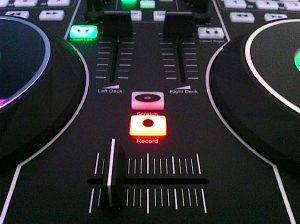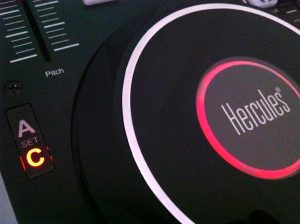Video Review
DJ controllers have come a long way in the past couple of years, and that’s easily demonstrated by looking at the [dj4set], which brings many of the functions of professional equipment into the reach of first-time DJs and general consumers.
Sure it’s small, built to a budget, and lacks many of the features of pro controllers. But just look at what it does have – jogwheels that sound convincing and are fun to use; four-deck DJing with built-in sound (ie no need for any other gear to DJ properly); one-button recording; and (albeit limited) access to looping, cueing and DJ effects.
The questions are, who will buy it, how well does it deliver the above features, and where does it fit in with the competition, of which there’s much at that end of the market? Let’s find out…
First impressions/setting up
Hercules sell this as a “large” controller, but it’s not – it’s compact, about the same size as the [djconsolermx]. What it does have is relatively large and chunky jogwheels, at least for the size of the controller. It’s made out of black plastic but is sturdy, with a properly screwed-down top plate, and rubber feet to keep it still (on a flat surface, at least).
The controls on Hercules controllers have always felt a little basic to me, and here the buttons are all exactly the same – one size and rubberised. They’re an improvement on the buttons on some previous Hercules controllers, but I’d have liked to have seen at least the play/pause and cue buttons a little bigger.
Most buttons light up green to indicate their state, except a few, like the shift buttons that light up orange, the deck buttons that light up red (to indicate whether the extra decks are selected), and the central red “record” button.

The faders are smooth, and the crossfader is pleasingly loose. Lights indicate whether deck A or C (left-hand side) or B or D (right-hand side) are selected.
At the front of the unit are 1/4″ inputs jacks for headphones and microphone, but there’s no 1/8″ headphone jack; it would have been good to see this as the target market for this controller is people who may have headphones that only have a 1/8″ plug on them.
Round the back there are only three sockets: a pair of RCAs for output, an 1/8″ stereo jack (also for master output – good idea! It means you can plug powered computer speakers straight in), and the USB socket. The unit draws its power from the computer.
To set up, you need to install a Hercules interface app called ControlPanel, then the supplied software, which is a product-specific version of Virtual DJ. This comes with skin to match the controller, and a layout that tries to match the way to the controller is laid out too.
There’s very little configuration open to you in the limited version of Virtual DJ as supplied, and indeed there are more configuration options in the supplied Hercules app! Here you can alter output volume and balance, the level of talk over attenuation (ie how much the music ducks when you speak into any attached microphone), the crossfader curve (two settings), and various output settings.
One setting you may want to tweak here is the jogwheel sensitivity. This determines not how light or hard you have to touch the jogwheels in order for them to work, but how much you have to turn them for them to move a set amount through your track.
They’re set to one-on-one, ie one revolution of the jogwheel on the unit equals one on the software screen, which felt roughly right to me, maybe a little over-sensitive.
In use
The jogs are fun. They are mechanical, but unlike other mechanical jogs – I’m thinking the [s4], the [ddj-s1] and the [ddj-t1] controllers – there’s no microswitch on the top panel; the whole jog clicks into the scratch mode when pushed down hard enough.
To avoid this mode, you just turn them without applying very much pressure. In practice, it’s a slightly different feel to both touch-sensitive jogs and microswitched dual-purpose ones, and it works fine – they feel good to use and kudos to Hercules for coming up with their own take on jogwheels. There’s something authentic feeling about them that I liked, and you can alter their tightness with screws underneath.

Virtual DJ is good software for beginners, but if the idea of four decks fills you with dread, you’ll be pleased to know it’s easy to turn them off and return to two. Otherwise, to select between decks, you just press the “DECK C” or “DECK D” buttons, and the software indicated which deck you’re on.
When using four decks like this, the unit utilises a system commonly referred to as “soft takeover”, which means that it remembers what the controls were set to when you return to a deck and you then have to move them back to that place to “take over” again. In practice, this is the best way of using four DJ decks with two sets of controls.
Beatmatching and sync
Virtual DJ doesn’t have complicated beatgridding like other software, but it does have a type of beatgridding. What you get on the unit is a sync button that is a one-off thing, whose job is to attempt to pull the two records you’re mixing with into beatsync with each other as it matches their BPMs. It works very well with electronic dance music, and with varying degrees of success with other music. If the beats start to drift, you just hit the “sync” button again.
In practice, I think this is fine for beginners, and it’s OK too for those who know how to beatmatch because the 14-bit (ie good) pitch faders and responsive jogwheels mean it’s easy to manually beatmatch. You could also easily learn beatmatching properly on this controller, so if you want a cheap way to get going, then brush up on some techniques, it’s worth looking at this model.
Sound-wise, the EQs are great – they cut 100% meaning if you turn bass, mid and treble all the way down, you hear nothing – this is good for mixing.
Other controls
The file browser is pretty standard. There’s no knob for scrolling, so you use up/down buttons instead. That’s OK, although a knob would be better. But the fact that the (limited) loops/cue/FX section doesn’t have even one control knob is a bit disappointing – to adjust the intensity of effects, you instead have to use up/down buttons, which is considerably less expressive.
Indeed, this whole section is limited. Loops work by hitting an “in” button then an “out” button, the software then looping a beatmatched section of the track that’s close to what you indicated. This helps to keep everything in time, but there’s no real manual looping.

Effects are likewise limited – you can use flanger, and two beat effects, one of which is called BeatGrid (nothing to do with beatgridding your tunes in the usual sense of the word) that’s actually quite fun, and another called FlippinDouble that again can add some excitement to your mixes. But apart from a flanger, that’s it – backspin and brake are available via the mouse and keyboard, but there are no filters or echo effects.
The manual alludes to the ability to access a few more options in this area, but I couldn’t work out how to do it. Overall, loops, effects and cueing are where the budget nature of this unit shows the most.
If you upgraded to Virtual DJ Pro 7 you’d get a lot more scope to alter the mappings and make those buttons suit your style of DJing a bit more, but if you were to pay for a better version of the program, I suspect you’d then want a controller with more physical knobs and buttons to assign your new-found functions to as well.
No keylock for four decks?
One omission here is keylock button on the hardware. With four decks, keylock is pretty much essential, because it allows you to get four music sources all in key with each other and start doing some clever stuff with them. It’s one of the benefits of four decks DJing. Also, without it, when you hit “sync”, Virtual DJ pulls the tune into line with the other or others that are playing, often by speeding it up, and this is audible clearly in the mix. If keylock were available, it would be far less noticeable.
As it is, the Hercules gives you the capability to use four decks, but without this function, your mixing might not sound as good as it could. While you can click a tiny padlock on the software to activate and deactivate it, would be much better to have it where you need it, under your fingertips.
The microphone, while a welcome addition to the spec (Hercules is aiming this unit at people who may well want to plug a microphone in at house parties, for instance), lacks any kind of effect like reverb or echo, which again is something Virtual DJ in more complex versions can easily provide. However, the fact that the unit has talkover is a plus point.
Conclusion
The Hercules is meant to be an entry-level controller, and it looks and feels it. It’s lightweight, built to a budget and it’s also small (when compared to most controllers, if not to other even more basic Hercules models). Its knobs and buttons all work well enough but there are only the basics.
The jogs, however, are good, and the crossfader is better than you might expect for the price. And I don’t know why other manufacturers don’t put an 1/8″ stereo jack on the back, as many people use this type of controller with decent computer speakers quite happily, and they nearly all come with a plug to fit this type of connector. Well done on this, Hercules.

The unit is clearly aimed at first-timers and hobbyist who want a cheap, simple unit they can experiment with and learn on. With the supplied software, it gives you some of the functions of pro gear, but not all, and so if you get serious you’ll want to upgrade – definitely the software, and eventually the hardware too. This has to be taken into account when considering the value of such a purchase.
However, at under US$250 it’s the cheapest four-deck DJ controller that’s out there, and unlike with some budget units, recording is both available and easy – one-touch, in fact – so you can listen back and review your development as a DJ. Being able to record your mixes is important, and it’s good that Hercules has made this easy.
Ultimately, though, don’t expect to sound like a pro on it as it lacks comprehensive looping, cueing and effects, some or all of which many pros use to get their sets sounding shipshape.
If you don’t want four decks, I’d still recommend the Mixtrack Pro as the best beginner’s controller. But if you really do want four decks and need to get them at an entry-level price, this will give you just that. If you’d like a more professional unit that’s similar, you may also want to consider the 4-mx, which adds back some of the things we missed having on the DJ 4Set.
Are you considering or do you have this controller? What’s your recommendation for a budget four-deck set-up? Let us know your thoughts in the comments.





![The 2024 Acapella & Stems DJing Revolution [Live Q&A] The 2024 Acapella & Stems DJing Revolution [Live Q&A]](https://cdn.digitaldjtips.com/app/uploads/2024/02/01185501/1feb-WEBSITE-150x150.jpg)


